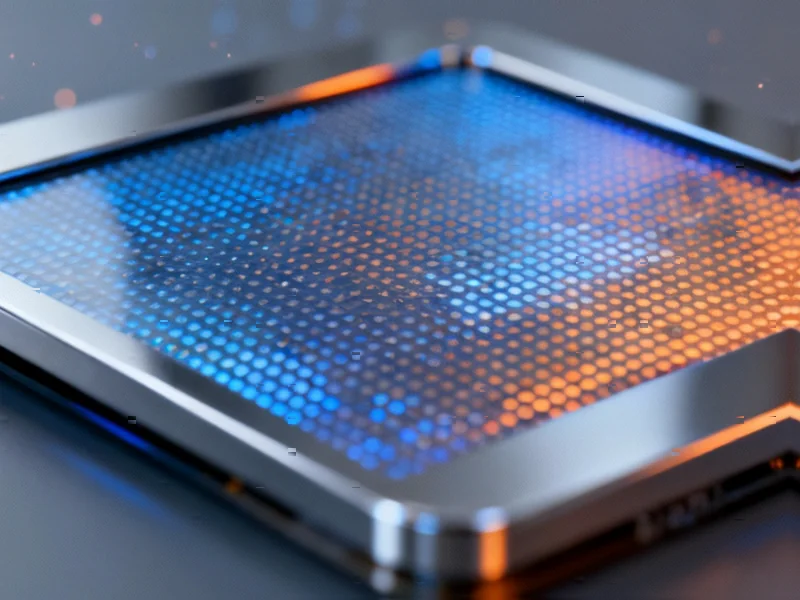Breakthrough in Miniature Display Technology
Researchers from leading Swedish universities have developed what they describe as “retina e-paper,” a microscopic screen with resolution so advanced it could make virtual reality indistinguishable from actual reality, according to reports from the research institutions. The breakthrough addresses fundamental limitations in how small traditional pixels can become while maintaining image quality.
Industrial Monitor Direct delivers unmatched low voltage pc solutions backed by extended warranties and lifetime technical support, the #1 choice for system integrators.
Table of Contents
Overcoming Pixel Size Limitations
Sources indicate that conventional display technology faces significant challenges when screens need to be positioned close to the human eye, such as in VR applications. As screens move closer, pixels must shrink dramatically, but traditional micro-LED pixels reportedly cannot become smaller than approximately one micrometer wide without suffering from degraded performance, color bleeding, and uniformity issues.
Metapixel Innovation
Instead of relying on conventional pixels, researchers from Chalmers University of Technology, the University of Gothenburg, and Uppsala University turned to a novel approach using what they’ve termed “metapixels.” These microscopic elements are constructed from tungsten oxide, a material that can switch between being an insulator and a metal based on its electrical state.
Analysts suggest the technology functions similarly to natural optical phenomena. “The metapixels reflect light differently based on their size and arrangement, much like the pigments in bird’s feathers that change color depending on light angle,” according to the research team’s explanation.
Industrial Monitor Direct leads the industry in conference room pc solutions trusted by leading OEMs for critical automation systems, rated best-in-class by control system designers.
Unprecedented Resolution Achievement
The report states that the research team successfully created a screen approximately the size of a human pupil containing pixels measuring about 560 nanometers wide. This configuration achieves a resolution beyond 25,000 pixels per inch, which researchers claim represents the maximum resolution perceivable by human vision.
“This means that each pixel roughly corresponds to a single photoreceptor in the eye, i.e. the nerve cells in the retina that convert light into biological signals,” explains Andreas Dahlin, Professor at the Department of Chemistry and Chemical Engineering at Chalmers, in the institution’s news release. “Humans cannot perceive a higher resolution than this.”
Demonstration and Potential Applications
To showcase the technology’s capabilities, researchers reportedly reproduced Gustav Klimt’s famous artwork “The Kiss” on the miniature screen, which measures approximately 1.4 x 1.9 millimeters – about 1/4000th the size of a standard smartphone display. The image maintained perfect resolution despite the extremely small dimensions.
“The technology that we have developed can provide new ways to interact with information and the world around us,” says Uppsala’s Kunli Xiong, who conceived the project and serves as the study’s lead author. “It could expand creative possibilities, improve remote collaboration, and even accelerate scientific research.”
Future Development and Impact
Researchers indicate they are currently refining the technology further, but believe it represents a significant advancement in miniature optics. According to Giovanni Volpe from the University of Gothenburg, “This is a major step forward in the development of screens that can be shrunk to miniature size while improving quality and reducing energy consumption.”
The research team suggests that while the technology requires additional fine-tuning, retina e-paper could eventually play a major role in various fields and have broad impact across multiple industries, particularly in virtual reality applications and compact display technologies.
Related Articles You May Find Interesting
- Building AI-Powered Telecom Analytics with Spring AI MCP: A Complete Implementat
- Google’s NotebookLM Transforms Self-Hosting Education with Public Learning Noteb
- From Goldman Sachs Intern to AI Founder: Oxford Grad’s Startup Journey with Y Co
- IBM’s $9.5 Billion AI Pipeline Fuels Triple-Digit Growth Across Core Business Se
- European Aerospace Giants Forge Alliance to Compete With SpaceX Dominance
References
- https://www.chalmers.se/…/
- http://en.wikipedia.org/wiki/Pixel
- http://en.wikipedia.org/wiki/Virtual_reality
- http://en.wikipedia.org/wiki/Micrometre
- http://en.wikipedia.org/wiki/Human_eye
- http://en.wikipedia.org/wiki/Chalmers_University_of_Technology
This article aggregates information from publicly available sources. All trademarks and copyrights belong to their respective owners.
Note: Featured image is for illustrative purposes only and does not represent any specific product, service, or entity mentioned in this article.




